Excerpts from Jim Conrad's
Naturalist Newsletter
from the July 10, 2016 Newsletter issued from Hacienda Chichen Resort beside Chichén Itzá Ruins; limestone bedrock; elevation ~39m (~128ft), N20.675°, W88.569°; central Yucatán state, MÉXICO
SPURGECREEPER
Twining up through a thicket of dead, weather-bleached stem-remains of last season's beautiful roadside Sunflower Goldeneyes, along a narrow, gravel road to a local garbage dump, a homely little vine with leaves caught my eye, simply because it was something green amid a lot of grayness. You can see the situation below:
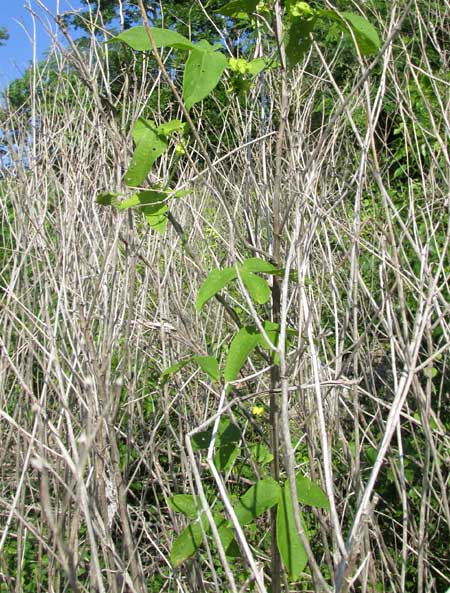
One of its deeply three-lobed leaves is shown below:

Its flower cluster was very unusual, with flowers mostly hidden inside two deeply lobed, leafy bracts a little paler green than the leaves, as shown below:
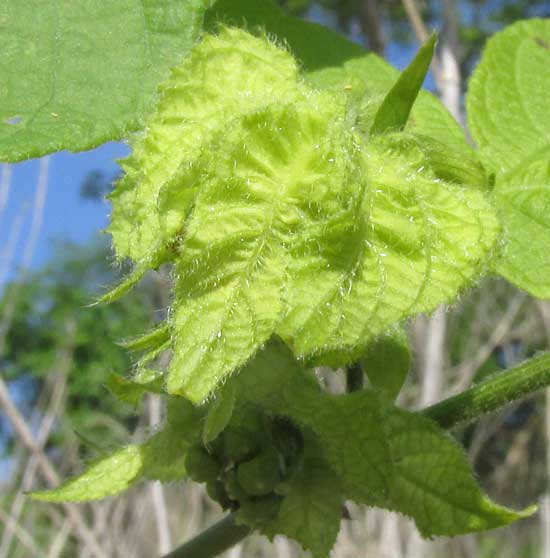
While taking these pictures I was thinking that something I'd not seen in the Cucumber/Melon Family had turned up, though I couldn't recall any species in that family producing such bracts. Since I don't see so well, it wasn't until I got home and put the following picture on the computer screen that it became apparent that not only was this in some other family, but that the flowering structures were outright bizarre. Below, you can see what I mean:
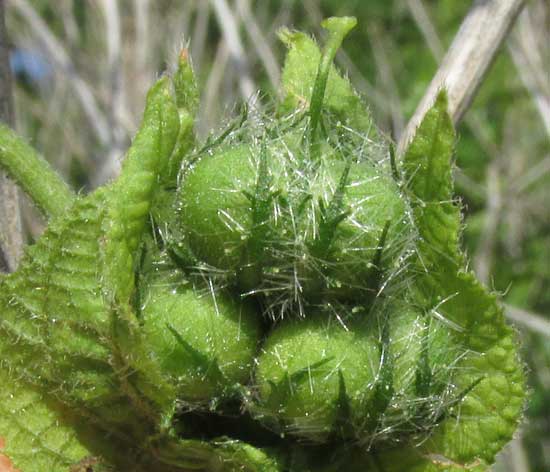
In this picture, notice the vertical, green, slender item atop the uppermost roundish thing. The slender thing is a style topped by an expanded stigma, so the roundish thing beneath it is an ovary. Notice that the ovary appears to be somewhat 3-lobed. The picture shows at least three ovaries, all subtended by slender calyx lobes equipped with stiff, white bristles. There's no hint of male flower structures in the picture. When you see a 3-lobed ovary with the style emerging where the lobes join, and the flowers are unisexual, you should automatically think of the big, widely occurring Spurge or Euphorbia Family.
In the world of flowers, certain species can bear several separate ovaries in a single flower, as appears to be the case here, but in those blossoms each ovary is not subtended by its own calyx or bracts, which each of these ovaries clearly is. I can't recall having ever seen anything like this. However, I did remember seeing pictures of a vining member of the Euphorbia Family enveloping its flowers with large bracts like this, so now that species finally had turned up.
It's DALECHAMPIA SCANDENS, sometimes in English known as Spurgecreeper, distributed from the southern US where it's sometimes weedy, southward through all the America tropics, plus, apparently, and surprisingly, also there are native populations in Africa.
There's plenty of scientific literature about the genus Dalechampia and its 100 or so species of twining vines, precisely because its flowering structure is so weird. Evolutionary biologists like to explain how things evolved to be the way they are, and this vine's "bibracteate inflorescences" have been hard to explain. It's more or less understood now to be a "terminal staminate pleiochasim juxtaposed to a 3-flowered pistillate cyme," as Grady and Barbara Webster at the University of California, Davis, describe it, but once such a kinky arrangement is recognized the question becomes, "What forces of evolution could account for such a curious thing?"
The ongoing attempt to explain it all has come up with some unexpected insights that, of course, just lead to more questions. For example, our local Spurgecreeper species has been shown to comprise two or maybe three or even more "cryptic species" -- cryptic species being populations in which it looks like all the individuals are of the same species, but then it's found that certain groups within the species don't interbreed with one or more other groups -- another. And, by definition, populations that don't interbreed with one another are considered different species. They're "hidden species," cryptic.
With our local Spurgecreeper species the mystery is even greater because sometimes the different cryptic species live in the same place, and even share the same pollinators, which are bees. How do the genetically isolated populations stay genetically isolated? Researchers in the field try to figure it out.
A further curiosity is that though each cluster of flowers on each Spurgecreeper vine bear both unisexual male and female flowers, and regular pollination definitely takes place, sometimes Spurgecreeper closes its bracts over its flowers, keeping out pollinators, and pollinates itself -- a process that seems to kick sand in the face of sexuality itself. Why have sex, Surgecreepers seem to be asking, when you can impregnate yourself exactly when you're ready?
Who would have thought that such an humble little vine might live such an iconoclastic existence? I'll be keeping my eye on this vine, hoping to find some male flowers, and maybe see other features of its strangeness.
from the May 24, 2018 Newsletter issued from Rancho Regenesis in the woods ±4kms west of Ek Balam Ruins; elevation ~40m (~130 ft), N~20.876°, W~88.170°; central Yucatán, MÉXICO
SPURGECREEPER MALE PARTS
Ever since two years ago when I took the flower picture at the bottom of the previous section I've been looking for the Spurgecreeper's male flowers. This week I found them. The breakthrough came when I was looking at the flower cluster shown beflow:
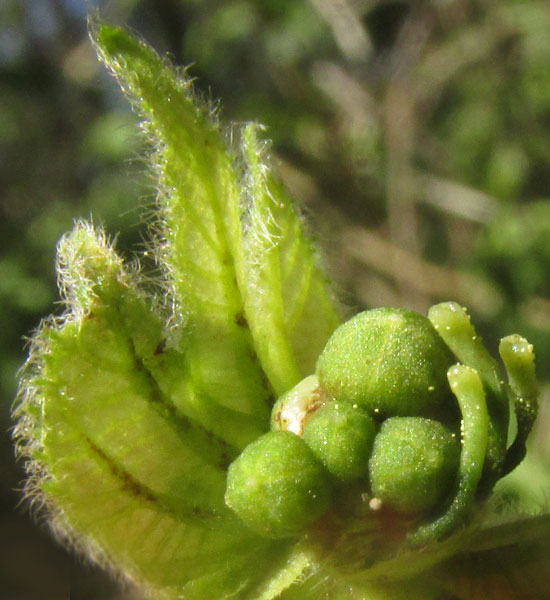
Most of the left side of that picture is occupied by the broad, leafy lower bracts subtending the whole cluster. So, what are the spherical items in the picture's lower, right corner, and what are those three curved, slender items to the right of the buds? These mysteries sent me looking into other clusters, where I found what's shown below:
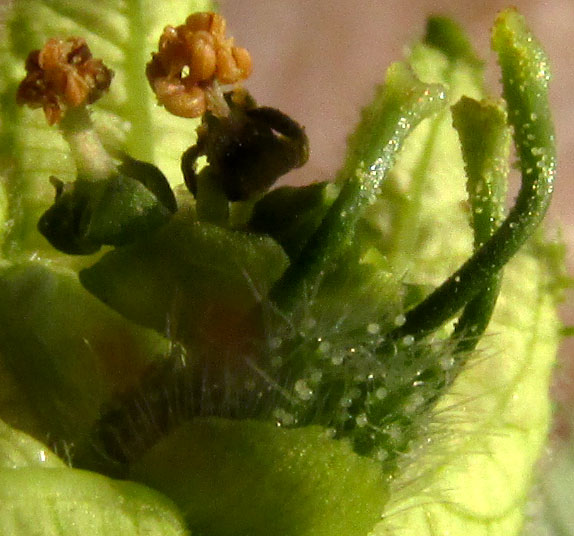
So, the spherical items had been unopened buds of male flowers. In the above photo, two buds have opened, revealing stout stalks composed of fused stamen filaments, and atop the filaments rest bundles of pollen-producing anthers. The green, slender, curving items at the picture's right are the female flowers' styles, topped by knobby stigmas. The styles' bases disappear below into a hairy zone in which the ovaries are hidden. Later the the ovaries will enlarge into fruits, in the center of which will arise the styles, as we saw two years ago.
Fortunately I had help interpreting these flower parts from the a illustrated 1972 article by Grady and Barbara Webster in the American Journal of Botany, entitled "The Morphology and Relationships of Dalechampia scandens (Euphorbiaeae)," which is freely available in PDF format. Just search on the title.
Of course all this is rather obscure botany, but when you treasure knowing various ways Nature has figured out how to do things, these often-hidden details are a pleasure to behold. Also, now I have a much more congenial relationship with our local Spurgecreepers, and look forward to finding someone who will ooh and ah when in real life they see what's on display here.